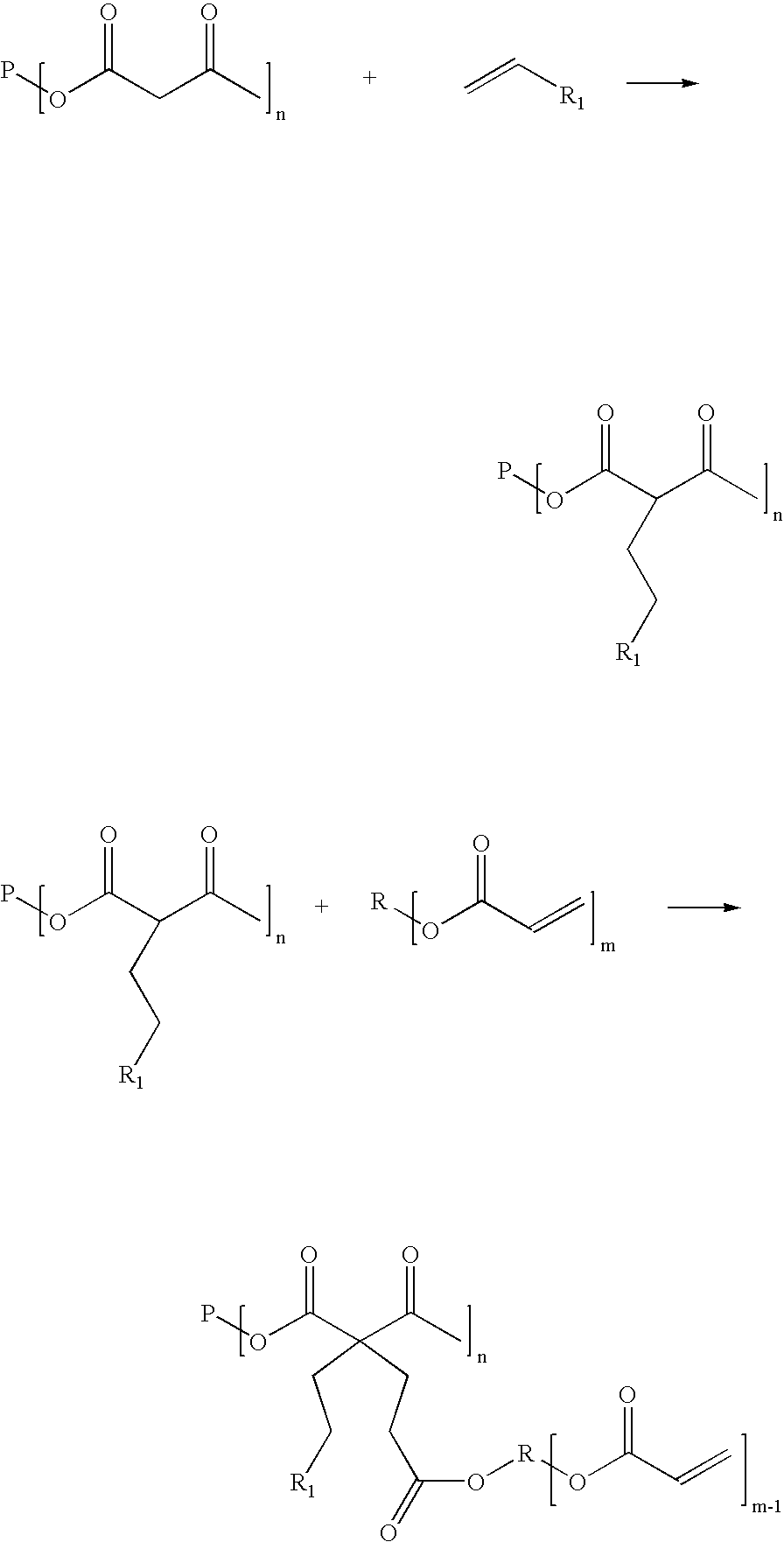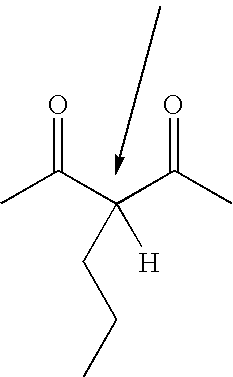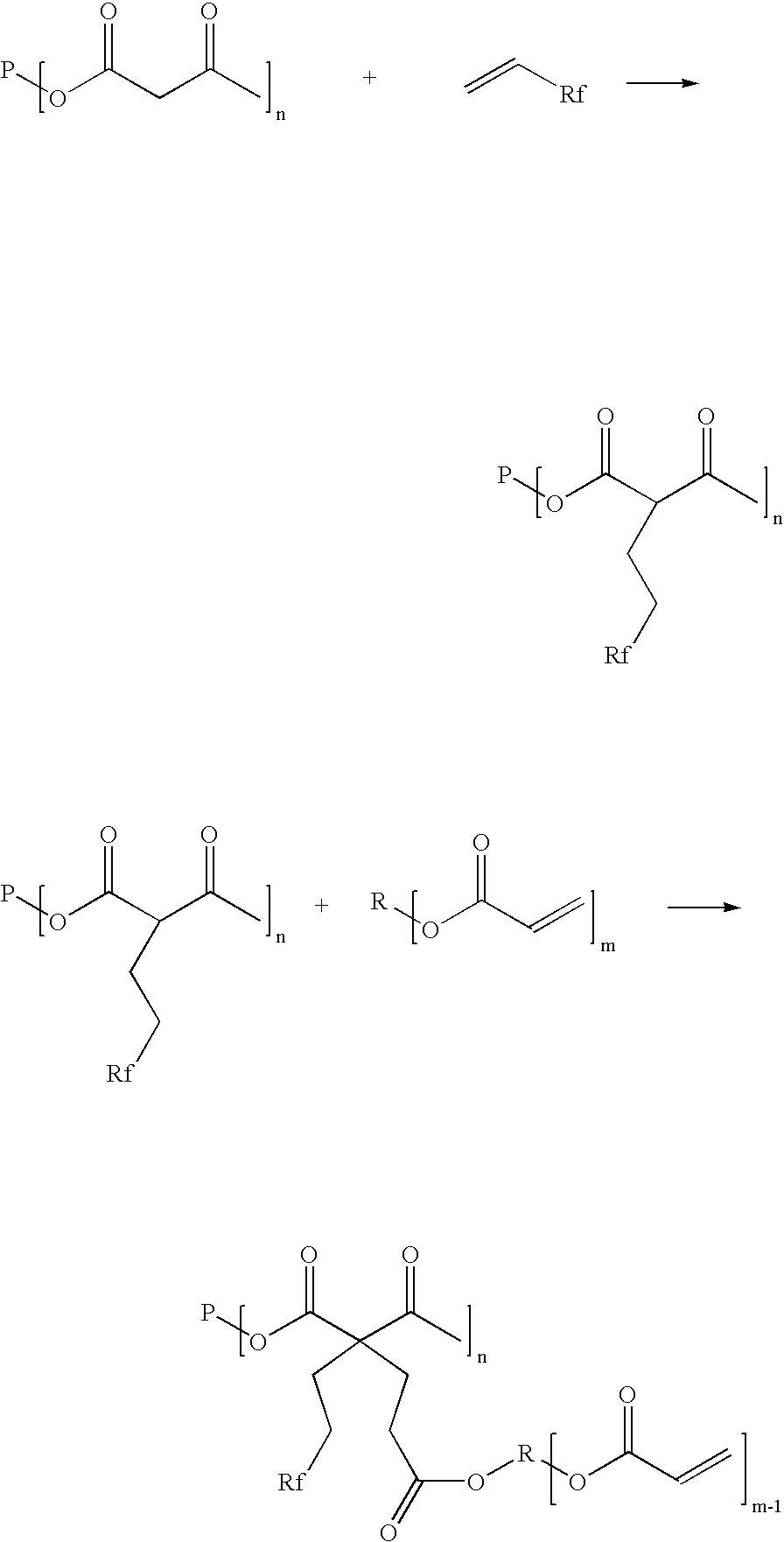Curable liquid acryloyl group containing resin composition
a technology of acryloyl group and composition, which is applied in the direction of railway components, chemical/physical/physicochemical processes based on energy, nuclear engineering, etc., can solve the problems of acrylic acid, carries the risk of spontaneous uncontrolled polymerization, and is not completely free of problems, so as to achieve less influence on product properties, improve adhesion to substrates, and economic benefits
- Summary
- Abstract
- Description
- Claims
- Application Information
AI Technical Summary
Benefits of technology
Problems solved by technology
Method used
Image
Examples
example 1-15
[0084] Into five 200 ml bottles was weighed 83.7 g of ditrimethylopropane tetracetoacetate(acetoacetate functionality=4, acidic C—H functionality=8). A different amount (see table 3, column 4) of the monomeric vinyl compound n-butyl acrylate was added to each bottle. Then, to each bottle was added 1% by weight(based on the total weight) of trioctyl phosphine (TOP) catalyst, the bottles were sealed and then shaken. After the mild exotherm had subsided, they were placed into a 72° C. oil bath for 6 hours. Gas chromatography analysis showed that butyl acrylate was completely consumed and gel permeation chromatography analysis and NMR analysis confirmed that butyl acrylate is attached to the acetoacetate groups. Table 1 shows the characteristics of the five intermediates A-E.
TABLE 1WeightWeightMilli-ConsumptionDi-TMP-Milli-butyl-equivalentof C—HDonorMilliequivalentNo(OAcAC)4equivalentacrylatC═CEquivalentsfunctionalityC—H / g (afterA83.7 g114364.O g50043.7%4.54.38B83.7 g114373.0 g57049.9...
examples 16-30
[0086] An acetoacetylated alkyd resin was prepared after the following procedure: A mixture of 148.0 g of phthalic anhydride, 119.0 g of 2-methyl-1,3-propandiol, 88.0g of trimethylol propane and 1.5g of dibutyltinoxide was stirred at 200-220° C. until 18 g of water was collected. Then, the temperature was lowered to 140° C. and 116.0 g of methyl acetoacetate was added. Then, the temperature was gradually increased to 160° C. and maintained until no more methanol was formed. Then, light vacuum was applied to remove small amounts of unreacted methyl acetoacetate. The acetoacetate base resin showed a viscosity of 8800 mPas @25° C. and an acetoacetate equivalent of 2.37 mmol / g (4.74 mequivalent C—H / g).
[0087] Into five 100 ml bottles was weighed each 30.0 g of the acetoacetate resin. A different amount of the monomeric vinyl component n-butyl acrylate (see table 3, column 3) was added to each bottle. Then, to each bottle was added 0.4% by weight (based on the total weight) of potassium ...
example 31
[0089] 700 g of gum rosin (colophony, acid value: 165 mg KOH / g, softening point: 70° C.) was stirred under nitrogen for 90 minutes at a temperature of 180° C. Then, 64.0 g of maleic anhydride was added. The temperature was maintained at 180° C. for 15 minutes, then raised to 215° C. and stirred at that temperature for 1 hour. A test with N,N-dimethyl aniline showed that at that point the reaction mixture contains no more free maleic anhydride. Then, a mixture of 155.0 g of pentaerythritol and 0.60 g of magnesium oxide was added in small portions. After the addition was complete, the temperature was raised to 265 to 270° C. The reaction mixture was stirred and the temperature was maintained until the acid value decreased to 10 mg KOH / g. The temperature was lowered to 140° C. and product was neutralized with a small amount of potassium hydroxide until the acid value dropped below 2 mg KOH / g and 116.0g of methyl acetoacetate was added. The temperature was gradually increased to 166° C....
PUM
| Property | Measurement | Unit |
|---|---|---|
| weight percent | aaaaa | aaaaa |
| weight percent | aaaaa | aaaaa |
| weight percent | aaaaa | aaaaa |
Abstract
Description
Claims
Application Information
 Login to View More
Login to View More - R&D
- Intellectual Property
- Life Sciences
- Materials
- Tech Scout
- Unparalleled Data Quality
- Higher Quality Content
- 60% Fewer Hallucinations
Browse by: Latest US Patents, China's latest patents, Technical Efficacy Thesaurus, Application Domain, Technology Topic, Popular Technical Reports.
© 2025 PatSnap. All rights reserved.Legal|Privacy policy|Modern Slavery Act Transparency Statement|Sitemap|About US| Contact US: help@patsnap.com



